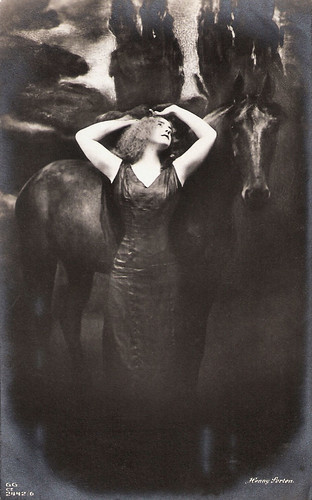Fern Andra

German postcard by Verlag Photochemie, Berlin / GGCo, no. 1885/4. Photo: Fern Andra Atelier.

German postcard by Verlag Photochemie, Berlin / GGCo, no. 2909/3. Photo: Fern Andra Atelier.
'Modern' American Fern Andra (1893-1974) became one of the most popular film stars of German cinema in the 1910s and early 1920s. In her films she mastered tightropes, riding horses without a saddle, driving cars and motorcycles, bobsleighing, and even boxing.

German postcard by Verlag Photochemie, Berlin / GGCo, no. 2920/3. Photo: Fern Andra Atelier.

German postcard by Verlag Photochemie, Berlin / GGCo, no. 2920/4. Photo: Fern Andra Atelier.
Henny Porten

German postcard by GG co., no. 2428/11.
Sturdy and blond Henny Porten (1890-1960) was one of Germany's most important and popular film actresses of the silent cinema. She became the quintessence of German womanhood, ladylike yet kindhearted and a not a little petit bourgeois. She was also the producer of many of her own films.

German postcard by GG co., no. 2442/6. With a black horse!
Die Nibelungen (1924)

German postcard by Ross Verlag, Berlin, no. 673/2, 1919-1924. Photo: Decla-Ufa-Film. Publicity still for Die Nibelungen: Siegfried (Fritz Lang, 1924). Siegfried (Paul Richter) in the forest.
Austrian actor Paul Richter (1895-1961) is best known as Siegfried, the hero who rides a shining white horse in the classic fantasy film Die Nibelungen (1924), situated in pre-Christian Germany. Die Nibelungen, directed by Fritz Lang, is one of the masterpieces of German silent cinema.

German postcard by Ross Verlag, Berlin, no. 675/1, 1924. Photo: Decla-Ufa-Film. Paul Richter in Die Nibelungen: Siegfried (Fritz Lang, 1924).

German postcard by Ross Verlag, Berlin, no. 675/2, ca. 1924. Photo: Decla-Ufa-Film. Paul Richter in Die Nibelungen: Siegfried (Fritz Lang, 1924). Siegfried and Alberich in the fog meadow. The meadow Siegfried has to cross is clouded in mist and framed by the dark branches of a leafless tree. Then slowly, very slowly, the white horse emerges through the mist, ridden by Siegfried dressed in white.
Sources: Richard Blank (Film & Light: The History of Filmlighting is the History of Film), Kristen M. Stanton (UniGuide), and IMDb.
No comments:
Post a Comment